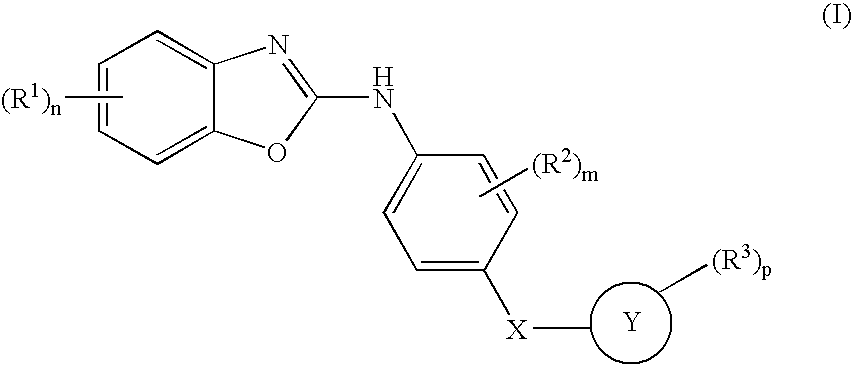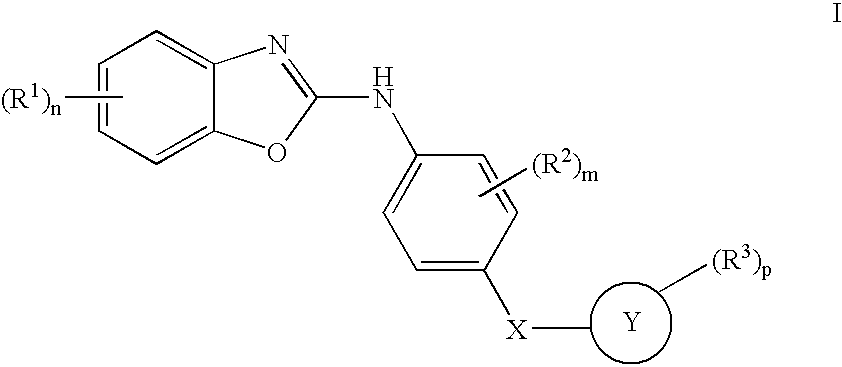1,3-Benzoxazolyl derivatives as kinase inhibitors
a technology of kinase inhibitors and derivatives, which is applied in the field of compounds, can solve problems such as cancerous growth of cells and visual degeneration, and achieve the effect of preventing sticking to the tablet casting mould and improving the availability of medicaments
- Summary
- Abstract
- Description
- Claims
- Application Information
AI Technical Summary
Benefits of technology
Problems solved by technology
Method used
Image
Examples
example 2
Preparation of (5-chloro-7-nitrobenzoxazol-2-yl)-[4-(pyridin-4-ylsulfanyl)phenyl]amine
[0250] The preparation is carried out analogously to the following scheme [0251] a 2 g of 2-amino-4-chloro-6-nitrophenol and 0.92 g of diimidazol-1-yl-methanethione are dissolved in 35 ml of dichloromethane and 15 ml of dimethylformamide and stirred overnight at room temperature. The solution is extracted with 1 N HCI. The organic phase is dried using MgSO4, filtered and evaporated to dryness under reduced pressure, giving 1.56 g of 5-chloro-7-nitro-3H-benzoxazole-2-thione. [0252] 100 mg of 5-chloro-7-nitro-3H-benzoxazole-2-thione and 88 mg of 4-(pyridin-4-ylsulfanyl)phenylamine are dissolved in 3 ml of dimethylformamide and stirred overnight at 110° C. The mixture is evaporated to dryness under reduced pressure, and the residue is purified with the aid of preparative HPLC, giving 40 mg of (5-chloro-7-nitrobenzoxazol-2-yl)-[4-(pyridin-4-ylsulfanyl)phenyl]-amine, an amorphous solid substance; rete...
example 3
Pharmacological Test Results
[0260]
Inhibition of TIE-2Inhibition of RAFCompoundIC50 (nmol)IC50 (nmol)(5-Chloro-7-nitrobenzoxazol-310>10002-yl)-[4-(pyridin-4-ylsulfanyl)phenyl]amine
[0261] The following examples relate to pharmaceutical compositions:
example 4
Injection Vials
[0262] A solution of 100 g of an active ingredient according to the invention and 5 g of disodium hydrogenphosphate in 3 l of bidistilled water is adjusted to pH 6.5 using 2N hydrochloric acid, sterile filtered, transferred into injection vials, lyophilised under sterile conditions and sealed under sterile conditions. Each injection vial contains 5 mg of active ingredient.
PUM
| Property | Measurement | Unit |
|---|---|---|
| Force | aaaaa | aaaaa |
| Ratio | aaaaa | aaaaa |
Abstract
Description
Claims
Application Information
 Login to View More
Login to View More - R&D
- Intellectual Property
- Life Sciences
- Materials
- Tech Scout
- Unparalleled Data Quality
- Higher Quality Content
- 60% Fewer Hallucinations
Browse by: Latest US Patents, China's latest patents, Technical Efficacy Thesaurus, Application Domain, Technology Topic, Popular Technical Reports.
© 2025 PatSnap. All rights reserved.Legal|Privacy policy|Modern Slavery Act Transparency Statement|Sitemap|About US| Contact US: help@patsnap.com



